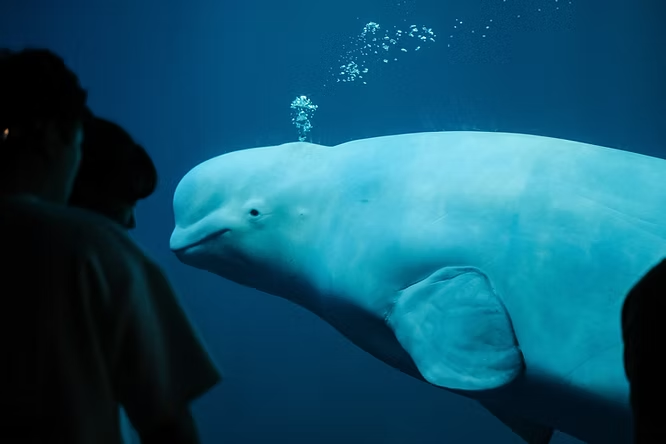Introduction
The beluga whale is a small yet distinctive toothed whale, born brown-gray and turning bright white in adulthood. It belongs to the “white whales” family alongside the narwhal. Because female and juvenile narwhals lack the males’ tusk, they are sometimes mistaken for belugas. However, belugas are more consistently white and slightly larger, reaching about 18 feet (5.5 meters) in length. Remarkably, they are the only cetaceans with a flexible neck, allowing them to move their heads in multiple directions.
Habitat and Distribution
Belugas inhabit the Arctic Ocean and nearby waters. During summer, they prefer shallow coastal zones, while in winter, they move toward ice edges. Some populations migrate seasonally over great distances, while others remain more resident. Occasionally, belugas venture far inland, swimming up rivers for hundreds of miles. These inland excursions remain somewhat mysterious, but their comfort in shallow waters is well documented.
Diet and Predators
Belugas feed on a wide range of fish and invertebrates. Their predators include killer whales and polar bears. Orcas typically chase belugas, while polar bears rely on ambush, using their strength to haul whales from breathing holes in the ice. To evade orcas, belugas may retreat deeper into ice-covered regions, but this strategy often exposes them to higher risk from polar bears.
Adaptations and Behavior
- Flexible neck: Unlike other whales, belugas can move their heads side-to-side and up-and-down.
- Shallow water tolerance: They survive strandings by waiting patiently for the tide to return.
- Vocal communication: Known as the “canaries of the sea,” belugas produce loud, clear calls that are audible above the water’s surface.
Conservation Status
Beluga whales are classified as near threatened. Their greatest challenges stem from environmental pressures rather than hunting. Climate change disrupts their icy habitats, while chemical pollutants in Arctic waters threaten their health. Although indigenous communities hunt belugas legally for subsistence, this is not considered a major risk to the species. Ongoing research highlights climate change and pollution as more pressing threats to their survival.
Conclusion
With their unique physical traits, playful behavior, and haunting songs, belugas remain one of the Arctic’s most iconic marine mammals. Yet, the changing climate and growing human impacts on their ecosystem underscore the urgent need for continued conservation efforts.

